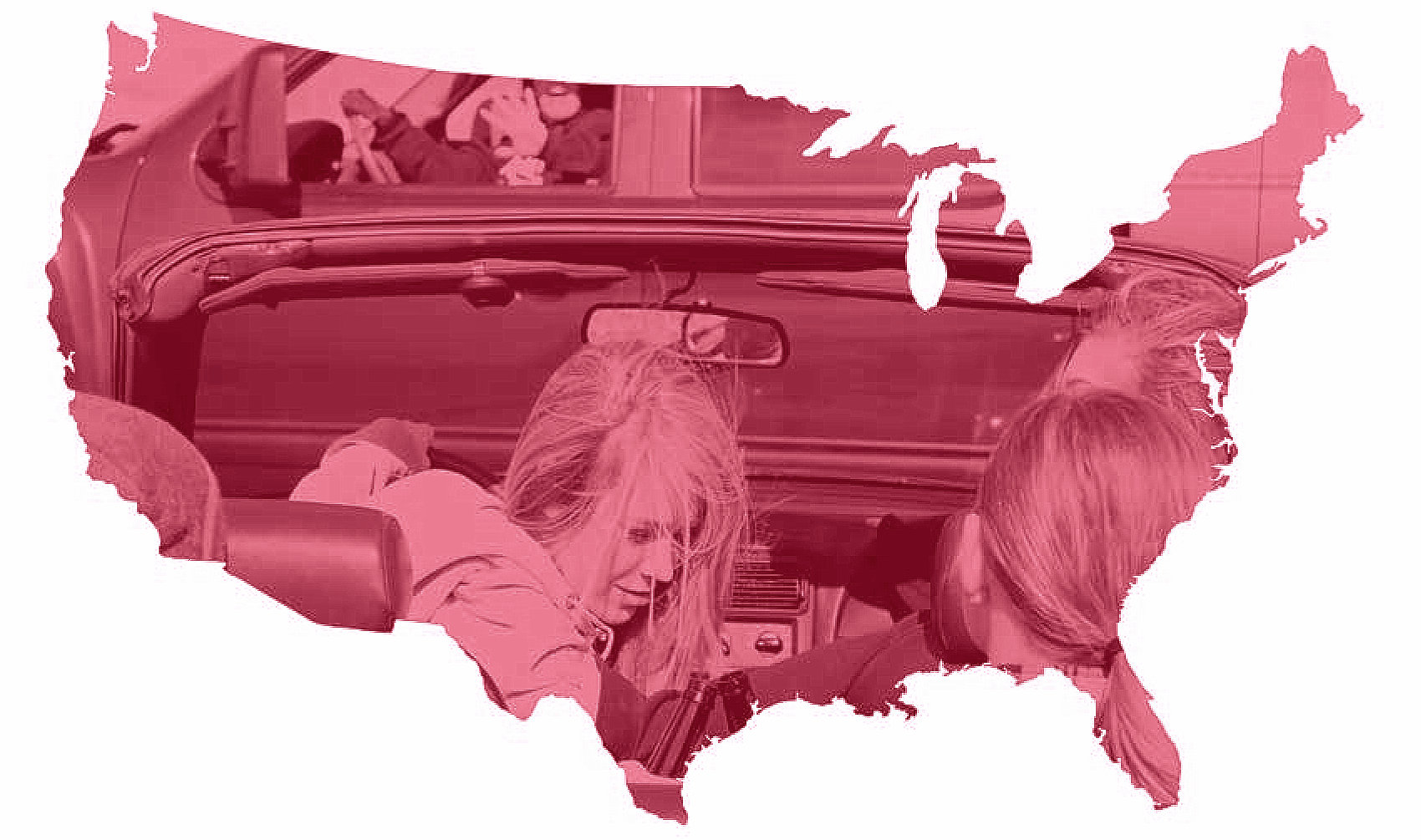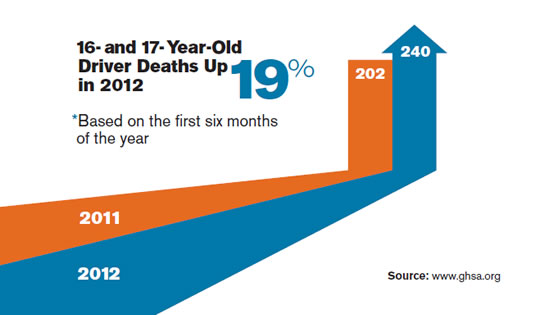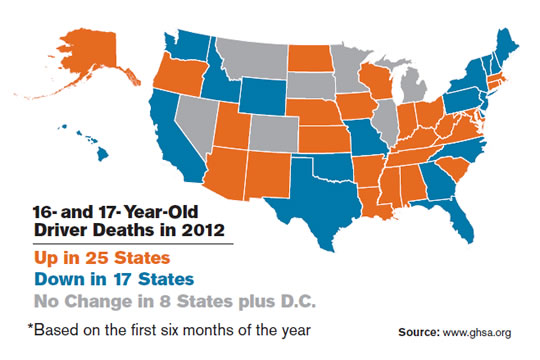By: Jeffrey Lapin
 The Governors Highway Safety Association (GHSA) released its Teenage Driver Fatalities by State – 2012 Preliminary Data Report, on February 26, 2013. The Report indicates that the number of 16- and 17-year-old drivers killed in motor vehicle crashes increased significantly in 2012 from 2011. The GHSA attributes a couple of reasons for this increase and offers some suggestions on reducing the fatality rate. While this is discouraging news, the total of number of driver deaths in this age group is still lower than it was from 2000 to 2007.
The Governors Highway Safety Association (GHSA) released its Teenage Driver Fatalities by State – 2012 Preliminary Data Report, on February 26, 2013. The Report indicates that the number of 16- and 17-year-old drivers killed in motor vehicle crashes increased significantly in 2012 from 2011. The GHSA attributes a couple of reasons for this increase and offers some suggestions on reducing the fatality rate. While this is discouraging news, the total of number of driver deaths in this age group is still lower than it was from 2000 to 2007.
TEEN DRIVER DEATHS BEFORE 2011
Between 2000 and 2010, 16-year-old driver deaths decreased by almost two-thirds, from 435 to 157 (64%), and 17-year-old driver fatalities were cut by more than half, from 564 to 253 (55%). From 2007 to 2010, there was almost a 50% decrease in the number of deaths of 16- and 17-year-old drivers. The GHSA attributes these decreases to the introduction and strengthening of Graduated Driver Licensing (GDL) systems that took place throughout this period as well as the 2008-2009 economic downturn in 2008-2009. The economy does have a factor in driving, by all aged drivers, but particularly for younger drivers who usually rely on their parents for money. Economic factors that affect driving include gas prices; costs of purchasing and maintaining a vehicle; and costs associated with obtaining a license, drivers education, maintenance and insurance.
GRADUATED DRIVER LICENSING (GDL) SYSTEMS
GDL systems are designed to delay full licensure of younger drivers so they can get more driving experience under lower-risk conditions. Most GDL systems have teen drivers go through three licensing stages: learner; intermediate; and full privilege. There are more restrictions placed on “learners” than “intermediate” drivers. States differ on the particular restrictions but many include: no cell phone usage or texting; no nighttime driver; and how many passengers, under a certain age, they can have in the vehicle. According to the Centers for Disease Control (CDC):
Research suggests that the most comprehensive graduated drivers licensing (GDL) programs are associated with reductions of 38% and 40% in fatal and injury crashes, respectively, among 16-year-old drivers.
Nebraska has its own GDL system and offers different licenses based on age and driving experience. Some of these GDL licenses include:
- Learner’s Permits (LPD): must be 15 years old or older; can only drive if they are with a licensed driver who is at least 21 years old.
- Provisional Operator’s Permit (POP): must be 16 years old or older; allows an individual to operate a motor vehicle unsupervised in Nebraska from 6:00 a.m. – 12:00 a.m. and during these hours if they are driving to or from home to work or a school activity; and may drive any time if he or she is accompanied by a parent, guardian, or licensed driver over 21 years old.
- Operator’s License (Class O): must be at least 17 years old if they had a POP for 1 year and have not accumulated 3 or more points during previous 12 month period, otherwise age 18.
Besides age, there are other requirements that a teen must meet to obtain either of these licenses.
THE GHSA 2012 REPORT FINDINGS AND CONCLUSIONS
Dr. Allan Williams, the main researcher for the GHSA study, obtained teen death information from every state and Washington D.C. for the first half of 2012. The study focused on 16- and 17-year-old drivers who died in motor vehicle accidents. The preliminary data for the first half of 2012 shows:
- Number of 16-year-old drivers that died in collisions: 107 (an increase of 24% from the first six months of 2011);
- Number of 17-year-old drivers that died in collisions: 133 (an increase of 15% from the first six months of 2011); and
- Combining 16- and 17-year-old driver deaths there were 38 more deaths in first half of 2012 than the same time period in 2011 (19% increase from the first six months of 2011);
By looking at the States individually the Report found:
- 25 States had an increase in the number of deaths of 16- and 17- year-old drivers with 5 of these States having an increase of 5 or more;
- 17 States had a decrease in the number of deaths of 16- and 17- year-old drivers with 3 of these States having a decrease of 5 or more;
- Nebraska had 4 deaths in the first half of 2012 while only 1 occurred in the same period in 2011; and
- The total number of deaths for the first half of 2012 was still lower than it was from 2000 to 2007.
The GHSA Report concluded that:
The upturn in deaths is a signal that renewed efforts are needed. Resources should be concentrated on measures that are already working or can be shown to work in reducing deaths. Graduated driver licensing is a solidly evidence based policy and has been credited with contributing to the drops in deaths that occurred up to 2010. There are further gains that could be made through strengthening existing laws, although the trend to make such upgrades has slowed down. Upgrades in driver education and training also are possible, have been introduced in some states, and need to be made in more states.
CONCLUSION
This author believes that, as GDL systems have been proven effective, additional studies should be conducted to determine the best GDL system. In addition, studies should focus on determining the risk factors commonly seen among teen driving fatalities and how they can be targeted.
Finally, parents need to play a more active role in helping their teen drivers stay safe. Things that parents can do include letting their teens practice driving as much as possible and prohibit driving when crashes are more likely to occur. Most importantly, parents, as well as all other people driving children of any age, should LEAD BY EXAMPLE: Do not drive distracted, speed, disobey traffic laws or fail to wear your seatbelt.
POST SOURCES
Information for this Post came from the following sources:
- CDC: Injury Prevention & Control: Motor Vehicle Safety
- GHSA News Release: New Study: Teen Driver Deaths Increase in 2012
- GHSA Spotlight on Highway Safety: Teenage Driver Fatalities by State: 2012 Preliminary Data
- GHSA: Teenage Driver Fatalities by State: Preliminary 2012 Data
- GHSA: Graduated Driver Licensing (GDL) Laws
- Nebraska Department of Motor Vehicle: An Overview of Graduated Licensing In Nebraska
Images are from the GHSA.
OTHER DRIVING-RELATED POSTS
- Study Finds Alcohol Deaths Drop After Price Increase
- Dramatic Increase in Fatal Vehicle Crashes Following Storm
- Going Beyond No Texting and Driving: Huron, South Dakota
- NHTSA Wants Hybrid and Electric Vehicles To Get Louder
- The ABC’s Of Safe Winter Weather Driving
ABOUT LAPIN LAW OFFICES
Lapin Law Offices urges all drivers to drive safely. We represent injured people and the families of those of have lost family members in motor vehicle crashes. If you have been injured or a family member killed in a crash you can contact us to learn more about your rights and what Lapin Law Office can do for you. We accept calls anytime (24/7) at 402-421-8033 (Lincoln), 888-525-8819 (Toll Free). You can also submit your case or question online (Contact Us). We offer a free initial consultation and do not collect a fee unless we get money for you.


